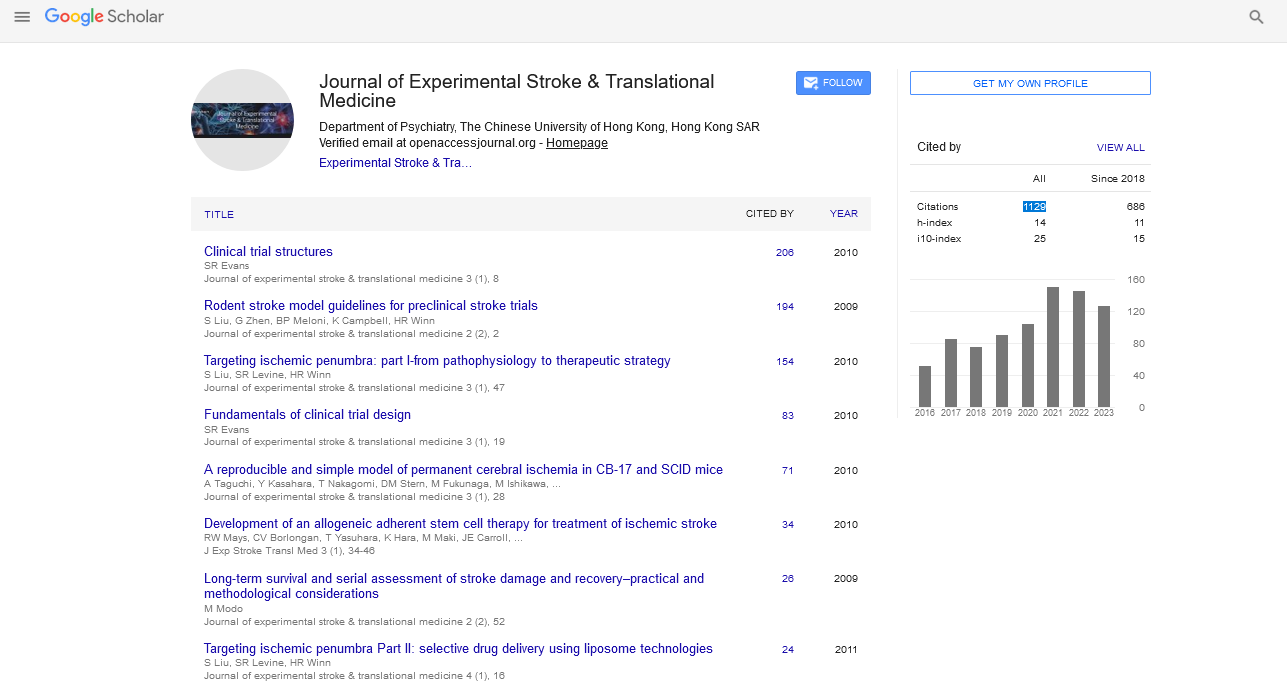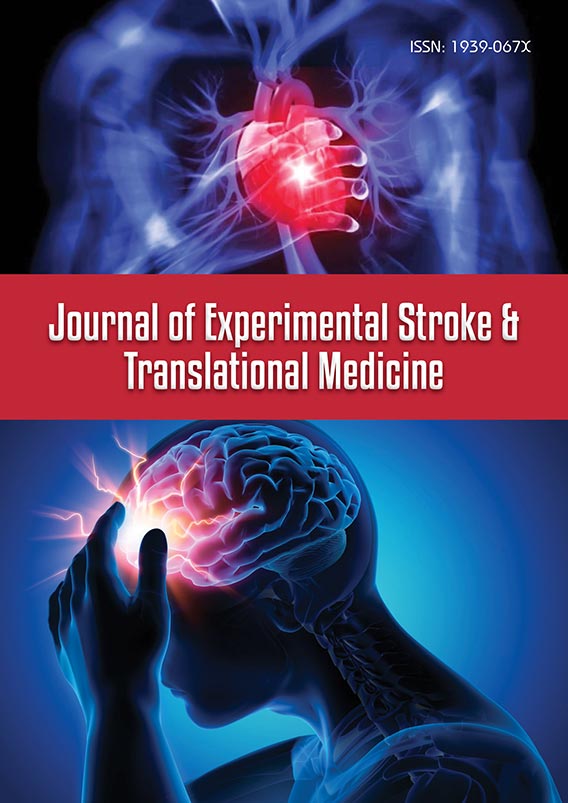Perspective - Journal of Experimental Stroke & Translational Medicine (2024) Volume 16, Issue 6
Stroke Rehabilitation: Path to Recovery and Independence
- Corresponding Author:
- David Cavazos
Department of Psychology, University of Calgary, Calgary, Canada
E-mail: dcavaz@tarleton.edu
Received: 04-Nov-2024, Manuscript No. jestm-24-153515; Editor assigned: 7-Nov-2024, PreQC No. jestm-24-153515 (PQ); Reviewed: 21-Nov-2024, QC No. jestm-24-153515; Revised: 03-Dec-2024, Manuscript No. jestm-24-153515 (R); Published: 31-Dec-2024, DOI: 10.37532/jestm.2024.16(6).293-294
Introduction
Stroke rehabilitation is a critical component of recovery for individuals who have experienced a stroke. It aims to help survivors regain as much independence as possible and improve their quality of life by addressing the physical, cognitive and emotional challenges that often arise after a stroke. This comprehensive process involves a multidisciplinary team, a personalized approach and a focus on long-term adaptation to maximize recovery outcomes.
Description
Understanding stroke rehabilitation
A stroke occurs when blood flow to a part of the brain is interrupted or reduced, leading to brain cell damage. Depending on the area and severity of the stroke, survivors may experience a range of impairments, including:
Motor function loss: Weakness or paralysis on one side of the body (hemiparesis or hemiplegia).
Speech and language difficulties: Aphasia, dysarthria or problems with comprehension and expression.
Cognitive challenges: Memory loss, difficulty concentrating and impaired problem-solving skills.
Emotional disturbances: Depression, anxiety and mood swings. Stroke rehabilitation is designed to address these deficits through a structured, individualized program that promotes neuroplasticity the brain’s ability to rewire itself and form new connections.
Key components of stroke rehabilitation
Physical Therapy (PT): Physical therapy focuses on restoring movement, strength, balance and coordination.
Therapists use exercises and techniques to help patients relearn basic motor skills and improve mobility.
Gait training: Helps patients regain the ability to walk independently.
Strengthening exercises: Target weakened muscles to enhance functional abilities.
Balance and coordination drills: Reduce the risk of falls and improve stability.
Assistive devices: Such as walkers, canes and braces, are used to support mobility.
Occupational Therapy (OT): Occupational therapy aims to help stroke survivors regain the ability to perform daily activities, such as dressing, bathing and cooking. Therapists work on improving fine motor skills, hand-eye coordination and upper body strength.
Adaptive techniques: Teach patients alternative ways to complete tasks.
Environmental modifications: Adjust the home environment to enhance safety and accessibility.
Use of assistive technology: Devices like grab bars, modified utensils and dressing aids can facilitate independence.
Speech and language therapy: Speech and language therapy addresses communication disorders and swallowing difficulties (dysphagia) that may result from a stroke.
Speech exercises: Help patients regain articulation and improve speech clarity.
Language therapy: Focuses on rebuilding vocabulary, sentence structure and comprehension.
Swallowing therapy: Involves exercises and dietary adjustments to prevent choking and aspiration.
Cognitive rehabilitation
Cognitive rehabilitation targets the mental processes affected by a stroke, such as memory, attention and executive functions.
Memory exercises: Enhance recall and information retention.
Problem-solving tasks: Improve decision-making and analytical skills.
Attention training: Helps patients focus on tasks for longer periods.
Emotional and psychological support
Emotional well-being is a crucial aspect of stroke rehabilitation. Many survivors experience depression, anxiety or post-stroke emotional disturbances.
Counseling and psychotherapy: Provide a safe space to address emotional challenges.
Support groups: Connect survivors with others who have experienced similar challenges, fostering a sense of community.
Medication management: Antidepressants or anti-anxiety medications may be prescribed when necessary.
The role of technology in stroke rehabilitation
Advancements in technology have revolutionized stroke rehabilitation, offering innovative tools to enhance recovery.
Robotic therapy: Assists in repetitive movements to promote motor recovery and strength.
Virtual Reality (VR): Provides immersive environments for practicing real-life tasks in a controlled setting.
Wearable devices: Monitor vital signs and track physical activity, enabling personalized feedback and progress tracking.
Tele-rehabilitation: Allows patients to access therapy sessions remotely, increasing accessibility and convenience.
The importance of early rehabilitation
Research shows that early intervention is critical for optimizing stroke recovery.
Rehabilitation should begin as soon as the patient’s condition stabilizes, often within 24 to 48 hours after the stroke. Early mobilization helps prevent complications such as:
Muscle atrophy: Loss of muscle mass due to prolonged immobility.
Contractures: Permanent shortening of muscles or joints.
Deep Vein Thrombosis (DVT): Blood clots that can form in immobile limbs.
Pressure ulcers: Skin breakdown from prolonged bed rest.
Long-term rehabilitation and community reintegration
Stroke rehabilitation is not a one-time event but an ongoing process. Many survivors continue to improve months or even years after the initial stroke. Long-term rehabilitation focuses on:
Community reintegration: Helping patients return to work, social activities and hobbies.
Home-based therapy: Exercises and activities that patients can perform independently at home.
Lifestyle modifications: Adopting a healthy diet, regular exercise and smoking cessation to reduce the risk of recurrent strokes.
Caregiver support: Providing education and resources to family members who play a critical role in the patient’s recovery.
Conclusion
Stroke rehabilitation is a multifaceted process that requires a personalized approach, dedication and the support of a multidisciplinary team. By addressing physical, cognitive and emotional challenges, rehabilitation empowers stroke survivors to regain independence and improve their quality of life. Early intervention, technological advancements and community support play crucial roles in maximizing recovery outcomes and helping individuals navigate the journey toward a fulfilling post-stroke life.

